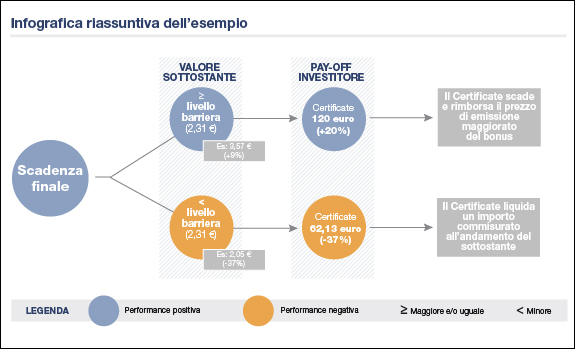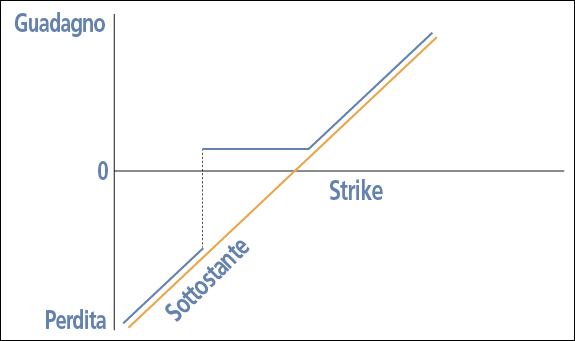Bonus Certificate

Che cosa è un Bonus Certificate
I Bonus Certificate sono strumenti finanziari derivati appartenenti alla categoria dei Certificate a capitale condizionatamente protetto che permettono di investire su un’attività finanziaria sottostante, quale ad esempio un’azione, un indice azionario, una valuta, una materia prima o un tasso di interesse. La peculiarità di questo tipo di strumento consiste nella possibilità di riconoscere all’investitore a scadenza un rendimento tramite il pagamento di un premio, il Bonus, anche nel caso di un moderato ribasso dell'attività sottostante. Per questa tipologia di Certificate, solitamente, la protezione del capitale a scadenza è condizionata al fatto che l’attività sottostante non raggiunga un determinato prezzo, denominato livello barriera.
A chi si rivolgono i Bonus Certificate
Questo tipo di Certificate è rivolto agli investitori con un propensione al rischio elevata, che hanno un’aspettativa di relativa stabilità, moderato rialzo o ribasso di una determinata attività finanziaria. La protezione del capitale è garantita a condizione che l’attività finanziaria sottostante non scenda sotto una determinata soglia chiamata livello barriera; in tal caso l’investitore può essere soggetto a perdite anche rilevanti in quanto il payoff finale rispecchierebbe la performance dell’attività sottostante.
Strumenti che offrono la possibilità di riconoscere a scadenza un premio: il Bonus
Quotazione e negoziazione dei Bonus Certificate
I Bonus Certificate sono strumenti finanziari che, in Italia, possono essere acquistati o venduti sui sistemi multilaterali di negoziazione SeDeX e EuroTLX di Borsa Italiana. Le modalità e orari di negoziazione presso tali sistemi multilaterali di negoziazione sono specificati nei relativi regolamenti disponibili sul sito internet di Borsa Italiana. Ad esempio, le negoziazioni continue possono avvenire nei giorni di mercato aperto dalle 9:05 alle 17:30 sul SeDeX e dalle 9:00 alle 17:30 su EuroTLX.
Caratteristiche dei Bonus Certificate
- SOTTOSTANTE: l’azione, l’indice azionario, la valuta, la materia prima o qualsiasi altro asset finanziario o reale da cui dipende il valore del Certificate;
- VALORE DI RILEVAZIONE INIZIALE o STRIKE PRICE: il valore dell’attività sottostante fissato alla data di rilevazione iniziale;
- VALORE DI RIFERIMENTO FINALE
- SCADENZA: la data in cui il Certificate cessa di esistere e viene determinato l’importo di liquidazione;
- EMITTENTE: l’istituzione finanziaria che ha emesso il Certificate;
- LOTTO MINIMO: il numero minimo di Certificate che possono essere acquistati o venduti;
- ISIN: il codice alfanumerico che identifica in modo univoco lo strumento finanziario;
- LIVELLO BARRIERA: il valore del sottostante sotto il quale l’investitore perde la protezione del capitale;
- BONUS: il premio corrisposto all’investitore se il sottostante registra una performance positiva o se l’andamento negativo non fa scattare l'Evento Barriera;
- CAP: eventuale limite massimo di partecipazione al guadagno del sottostante che l’emittente riconosce, a scadenza, al possessore del Certificate;
- MULTIPLO: ossia la quantità di sottostante controllata da ciascun Certificate e pari al rapporto tra il prezzo di sottoscrizione in fase di emissione del Certificate e il Valore di Riferimento Iniziale.
Funzionamento e pay-off dei Bonus Certificate
I Bonus Certificate permettono all’investitore di ottenere un rendimento sul capitale investito, il Bonus appunto, anche nel caso di un eventuale ribasso dell'attività sottostante. La possibilità di conseguire il Bonus è assicurata salvo che il valore dell'attività sottostante non raggiunga un livello predeterminato ed espresso in termini percentuali chiamato livello barriera. La rilevazione della barriera può essere a scadenza, o durante tutta la vita del Certificate. Nel caso di raggiungimento del livello barriera, l’investitore a scadenza riceve un Importo di Liquidazione correlato all’andamento del sottostante. Alla scadenza del Bonus Certificate due sono i possibili scenari in cui può incorrere il detentore del Certificate.
- Se il valore del sottostante non ha raggiunto il Livello Barriera, l’investitore riceverà il maggiore tra:
- il valore del capitale investito maggiorato della performance del sottostante alla data di scadenza;
- il bonus, che rappresenta una percentuale maggiore del 100% del prezzo di emissione
- Se il valore del sottostante ha raggiunto il livello barriera, l’investitore riceverà un importo di liquidazione corrispondente all’andamento del sottostante.
Esempio di funzionamento
Si ipotizzi un Bonus Certificate avente come attività sottostante un’azione Intesa Sanpaolo con le seguenti caratteristiche:
| Scadenza | 2 anni |
|---|---|
| Prezzo di emissione | 100 € |
| Data di rilevazione iniziale | 21/07/2014 |
| Valore di riferimento iniziale | 1,3 € |
| Data di rilevazione finale | 21/07/2016 |
| Bonus | 120% (1,56 €) |
| Livello Barriera | 0,91 € (pari al 70% del Valore di Riferimento Iniziale) |
In seguito vengono rappresentati i due possibili scenari che alla scadenza del Bonus Certificate possono manifestarsi all’investitore:
- l’azione Intesa Sanpaolo al termine delle contrattazioni della seduta del 21 luglio 2016 vale 1,40 Euro. Il valore di rilevazione finale è maggiore del livello Barriera posto a 0,91 euro. L’investitore incassa i 100 Euro del valore di emissione del Certificate più i 20 Euro del Bonus (120%);
- l’azione Intesa Sanpaolo al termine delle contrattazioni della seduta del 21 luglio 2016 vale 0,80 Euro. Il valore di rilevazione finale è inferiore al livello barriera posto a 0,91 Euro. L’investitore perde la protezione condizionata del capitale e registra una perdita commisurata all’andamento del valore dell’attività finanziaria sottostante e l’Importo di liquidazione risulta pari a:
Importo Liquidazione = Valore di riferimento finale x Multiplo x Lotto Minimo di Esercizio
Andando a inserire i dati riportati nell’esempio abbiamo:
Importo Liquidazione = 0,80 x 76,9231 x1 = 61,54 Euro


Esempio grafico payoff Bonus Certificate

Per approfondimenti sui termini è possibile consultare l' apposito GLOSSARIO